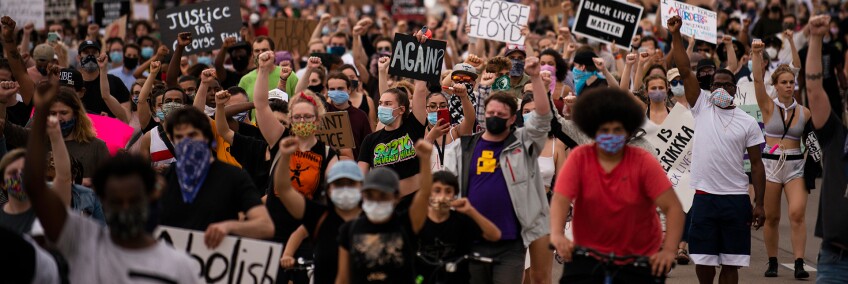In California, A History of Young, Powerful Voices in Journalism Emerge

A 17-year-old girl galvanized a global protest this year with a single smartphone video.
When Darnella Frazier filmed Minneapolis police officer Derek Chauvin kneeling on the neck of George Floyd, Jr., on May 25, until he died, anguished people from around the world poured into the streets. Specifically, in the U.S., demonstrators in all 50 states braved a pandemic to protest for more than 100 consecutive days in some towns.
As a scholar who studies how marginalized communities use mobile media during times of crisis, I was astonished to discover that the most important filmmaker of the century was a child. How did she have the wherewithal to record so steadily, I wondered? How did she know not to make a sound or pan away?
It shouldn't be too surprising. As the latest installment of the KCET documentary "City Rising" shows California teens are responsible for some of the biggest legislative reforms that the state has seen in the last decade. While they lobby to improve education, immigration policy and policing in their communities — through protests and door-to-door canvassing — the youth also embrace the power of journalism as an essential tool of civic engagement.
In Fresno, for example, teen podcasters Zofia Trexler and Raymart Catacutan are part of an organization called The kNOw Youth Media, which has hosted after-school writing workshops and media production instruction since 2006. The kNOw is part of a broader media consortium called the Youth Leadership Institute (YLI), which boasts four other journalism training programs throughout California: Calafia, Coachella Unincorporated, VoiceWaves and We-Ced.
YLI youth has led more than 100 successful campaigns to change local and statewide policies since its inception in 1991, even before the days of smartphones and social media. What dates back even farther is young people's desire to leverage journalism for grassroots activism — especially among youth who identify as Black, Indigenous and People of Color (BIPOC).

Black youth in Northern California once published one of the nation’s most influential newspapers
In the African American community, the Black Panther Party for Self-Defense arose in Oakland to protect Black people from police brutality. Two college students, Huey Newton and Bobby Seale, formed the organization in 1966. Their leadership formed the vanguard of the Black Power Movement, as the Panthers grew chapter after chapter across the U.S. Perhaps a lesser-known fact, however, is that the group published an independent newspaper too: The Black Panther. And young journalists staffed it.

The Black Panther reported on social justice-oriented issues from 1967 to 1980. Its debut front-page story features a piece that could have been written last week. "Why was Denzil Dowell killed?” explores the death of a 22-year-old, unarmed Black man in Richmond, Calif., at the hands of police. The second issue outlined the party’s famous “10-Point Program” for racial and economic equality.
The Black Panther was an essential communication tool for the organization and an entry point for many new members. Billy X Jennings, for example, has said that the chanting he heard outside of his college lecture hall window enticed him to leave class one day in 1968. As Jennings crossed the street from Oakland’s Laney College to the courthouse, he realized that fellow students were demanding that charges be dropped in Huey Newton’s case, which alleged that he killed a local police officer. Jennings joined the organization that day. He got his start as a staffer for The Black Panther. Judy Juanita, a fellow Laney College student, was its editor-in-chief at the time.
“Every Wednesday evening, Jennings recalled, he and dozens of Panthers and volunteers gathered in a converted storefront office in San Francisco’s Fillmore district to prepare the newspaper for distribution,” Jessica Lipsky wrote for Columbia Journalism Review. She added: “They formed an assembly line, folding and bundling the papers, then loading the bundles onto trucks double-parked on Geary Boulevard. The pace of the work was demanding, but the atmosphere was festive.”
The Black Panther Party required all members to read its newspaper, alongside a mandatory list of Black history books. At its height, between 1968 to 1971, The Black Panther was the most-read Black newspaper in America, with an external audience of more than 250,000 subscribers. Internally, the publication linked 48 Party chapters in more than two dozen major U.S. cities.
Young Chicano activists once led the largest student walkout by leveraging media
Just as the Panthers were growing the Black Power Movement in Northern California (and beyond), various Chicano youth groups were building a Brown Power Movement in Southern California. Years of discrimination against the community — such as the illegal deportation of Mexican Americans during the Great Depression and the Zoot Suit Riots of 1943 — propelled a new generation of Chicano youth to fight for their rights. In 1968, a coalition of students led the East Los Angeles Walkouts (or "Blowouts") to demand better education. More than 20,000 students across five high schools — Belmont, Garfield, Lincoln, Roosevelt and Wilson — left their classrooms that March.
At the time of the students’ uprising, the dropout rate for Mexican Americans was an abysmal 60% of its total student population. If Mexican Americans did manage to graduate, they most often read only on an eighth-grade level since prejudice amongst teachers and administrators was rampant. In response to this treatment, groups such as the United Mexican American Students and the Young Chicanos for Community Action (which later became the Brown Berets) worked alongside La Raza newspaper publishers to organize the walkout for many months.
Episcopalian Reverend John Luce, and two local college-aged activists, Elizier “Risco” Lozada and Ruth Robinson, founded La Raza in 1967. The trio advised high school student Blowout leaders, like Vickie Castro, through Luce’s Social Action Training Center (SATC), which ran out of his Lincoln Heights-based Church of the Epiphany. At SATC, young Chicanos learned how to leverage photojournalism to tell the story of police brutality, segregation and protests in their communities. During its 10-year run, La Raza amassed an archive of nearly 25,000 images shot by its young activist-photographers.
On the first day of the walkouts, La Raza youth were there with their cameras ready — even though much of the broader L.A. community was unaware of what was to come. The staffers also spent the next few days of the walkout articulating the students' demands in its pages for more culturally relevant learning material; an increase in Mexican American teachers and administrators; and the freedom to speak both English and Spanish in their classrooms.
While the students of the March 1968 walkout did not yield immediate results, historians have credited the student movement with boosting Chicano pride and activism in L.A. throughout the next decade. Slogans such as “¡Viva la Raza!” and “¡Viva la revolución!” were born out of this struggle. Moreover, a year after the walkouts, UCLA’s enrollment of Mexican Americans surged, from 100 to 1,900 students. The Brown Power Movement is also said to be responsible for a cascade of new Chicano Studies programs throughout the University of California system and increased mainstream news coverage of Mexican American issues in the 1970s and 1980s.
Student journalism remains a cornerstone of youth protest
As the United States embarked on one of its most contentious Presidential elections in recent memory, many of the tightest races were determined by youth, ages 18-29. In fact, voter turnout in this age bracket surged by 8%; 53% of eligible young voters cast ballots this year versus 45% in 2016. Some analysts are crediting Gen Z’s rising interest in politics by describing what it has lived through. They came of age in an era of highly-mediated mass tragedy, such as school shootings or fatal police encounters, many have written. They are also living through unprecedented instability that has been brought on by a global pandemic.
In addition to these analyses, we would do well to consider the speed and sophistication with which this generation can produce protest journalism. They can teach each other and organize at unprecedented rates. Smartphones and social media have given today’s BIPOC activists even more reach than their predecessors at The Black Panther or La Raza. Whether it is 17-year-old Darnella Frazier stepping up to be a witness for George Floyd, Jr. — or youth here in California, publishing through YLI — young people everywhere are demonstrating that journalism remains a cornerstone of youth protest.
Fresno teen podcaster, Zofia Trexler, explained at the end of “City Rising”: "As a generation, I feel like we've reached this consciousness that it's alright to be disruptive. It's alright to not be civil when kids are in cages, and our friends are being deported, and we are being saddled with all these problems we did not create."
As Trexler continues to list the many challenges that her peers face, one cannot help but notice how eerily identical her concerns are to those of the youth activists before her, in the late 1960s Black and Brown Power Movements. The police brutality has persisted. The fight for immigrants’ rights has persisted. Trexler is persuaded, however, that youth will continue to be part of the nation’s best solutions. They will have to document their protest though, she noted, so that the journalism becomes part-archive and part-political vigilance.
She said part of the fight “is realizing that liberation and our quest for equality and equity — that’s going to be a constant struggle that we fight throughout our lives.”








